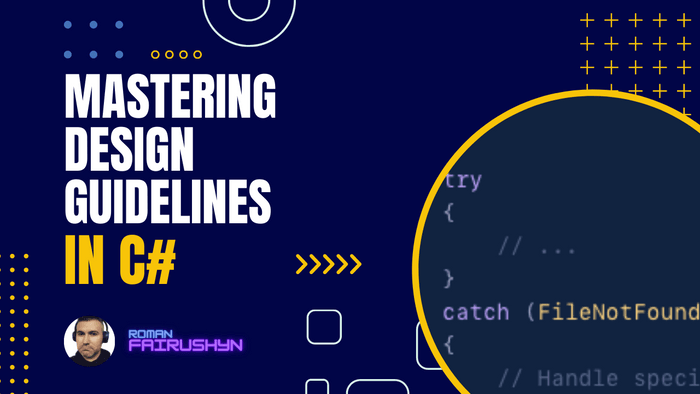Mastering Design Guidelines in C#
4 min read · — #csharp-interview#junior#design-guidelines
Ah, the art of writing elegant, maintainable, and efficient C# code! While the junior dev might be ensnared by the basics, it's the nuanced understanding of design guidelines that sets apart a Software Engineer. In today's technology-driven landscape, the demand for developers who not only write code but craft solutions is higher than ever. And guess what? If you're gearing up for that high-profile technical interview, there's a good chance you'll be quizzed on these very principles. But fret not! Let's delve into the world of C# design guidelines, where every recommendation has a story, every guideline is the result of years of cumulative experience, and every best practice is your stepping stone to code nirvana.
1. Naming Conventions:
Consistency is the key. Adhering to naming conventions makes your code readable and maintainable.
- Pascal Case for type names and method names:
public class UserProfile
{
public void DisplayInfo() { ... }
}- Camel Case for local variables and method parameters:
int userCount = 0;
public void SetDetails(string userName) { ... }2. Accessibility Modifiers:
Always be explicit about the accessibility level of your classes and members.
Use 'private' explicitly: Even though fields are private by default, specifying it explicitly aids clarity.
private int userId;3. Avoiding Magic Numbers:
Instead of embedding numbers directly in your code (aka "magic numbers"), use named constants.
const int MaxUsers = 100;
if (userCount > MaxUsers) { ... }4. Proper Exception Handling:
Avoid catching general exceptions. Always aim to catch the most specific exception type.
try
{
// ...
}
catch (FileNotFoundException ex)
{
// Handle specific exception
}5. Proper Use of Properties vs. Methods:
If an operation is computationally complex or has side effects, use a method. Otherwise, consider using a property.
- Bad:
public int GetAge() { return age; } // This should be a property.- Good:
public int Age { get; set; }6. Understand the Nuances of const vs. readonly:
Both const and readonly indicate immutability, but they serve distinct purposes.
const: Represents a genuine compile-time constant and is suitable for primitive types that have values determined at compile time.
public const double Pi = 3.14159265359;readonly: Use this when you want a value, set at runtime, that shouldn't change afterward.
public class MyClass
{
public readonly DateTime CreationDate;
public MyClass()
{
CreationDate = DateTime.Now;
}
}In your design decisions, choose the one that aligns with the lifecycle of the value you're working with. While const
is perfect for true constants, readonly offers runtime flexibility with post-construction immutability.
const:
- Represents a compile-time constant.
- Can only be a primitive type (like int, double, string, etc.).
- Value is determined at compile time, meaning you can't set it based on runtime calculations or decisions.
- Is static by nature. You don't need to create an instance of a class to access a const member of that class.
readonly:
- Can be set either in the constructor of the class or at the declaration.
- Allows for runtime assignment. For instance, it can be set based on a parameter passed to a class's constructor.
- Can be either an instance-level or a static member.
Given the distinctions:
- If you have a genuine compile-time constant, particularly a primitive type, then const is more appropriate. For example, defining mathematical constants like Pi, or setting configuration flags that must be determined at compile time.
- If you want to set a value at runtime that should not change afterward, then readonly is the way to go. This is especially useful for values that are determined upon instantiation of an object.
7. Dispose of Objects Properly:
Always ensure you dispose of objects that implement IDisposable. Using the using statement can be a neat way to ensure this.
using (StreamReader reader = new StreamReader("file.txt"))
{
// ...
}8. Favor is and as Operators for Type Checks and Casts:
Using the is operator checks for type compatibility, and the as operator attempts a cast, returning null if unsuccessful. This avoids exceptions and is more readable.
if (obj is User)
{
User user = obj as User;
// Use user object
}Conclusion
Design guidelines in C# are more than just rules—they represent a shared understanding among developers about what works best. For a Software Engineer, mastering these guidelines is crucial not only for coding excellence but also for effective collaboration and mentoring. So, as you prepare for your technical interview, remember that each guideline carries with it the wisdom of countless developers who have journeyed before you.
Here's to crafting exemplary C# code! Cheers!
